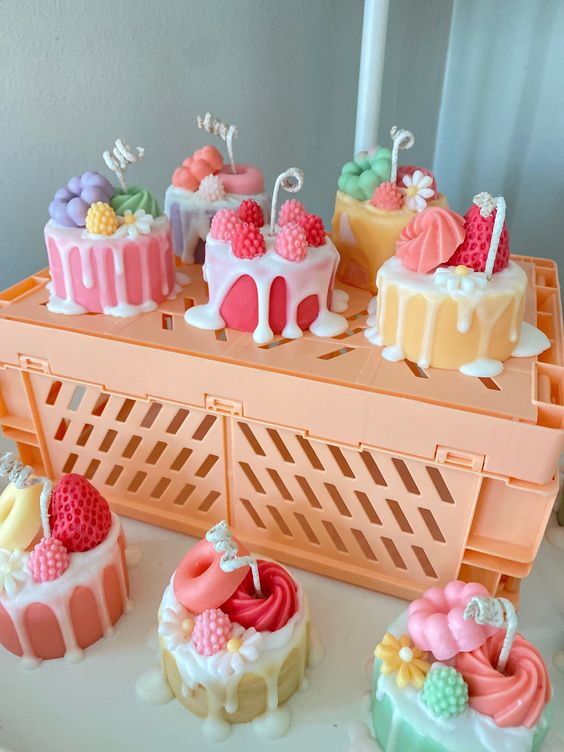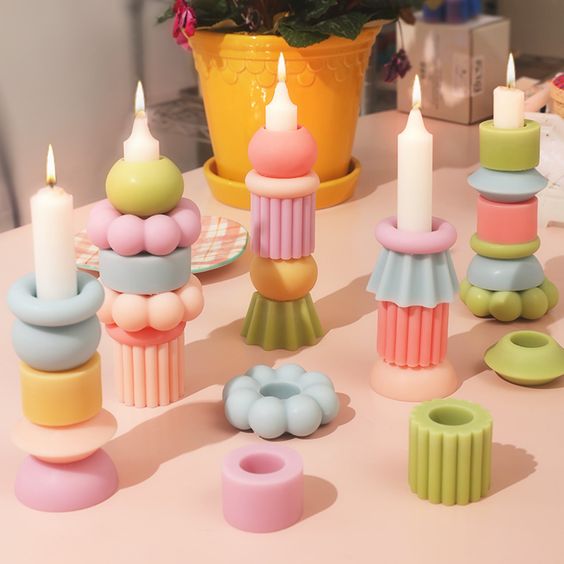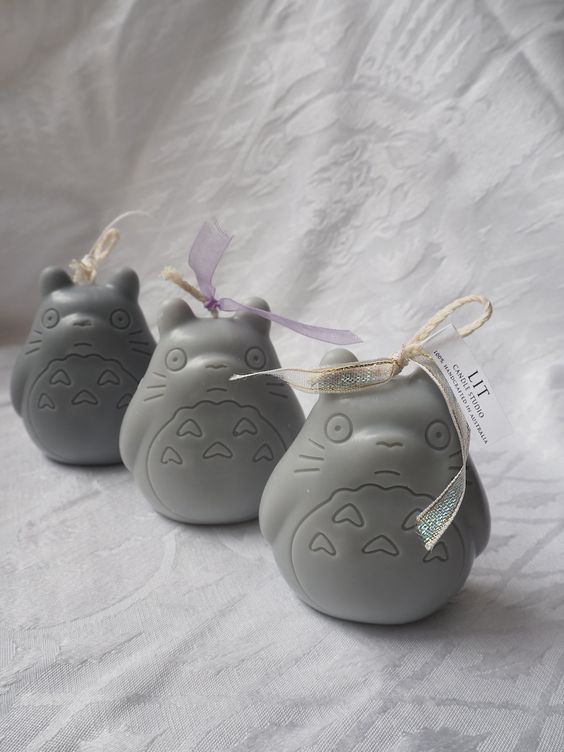Bajo la luz de las velas: El arte y la ciencia de la fabricación personalizada de velas

En el ámbito de la personalización, las velas han trascendido sus humildes orígenes como simples proveedores de luz y calor. Se han convertido en instrumentos de expresión individual y emoción, elementos indispensables en la decoración del hogar y espacios personales. Con el avance de la tecnología de moldes de silicona personalizados, cualquiera puede ahora crear arte único en velas desde la comodidad de su hogar. Estos moldes no solo son una puerta a infinitas posibilidades creativas, sino que también son preferidos por su facilidad de uso y altos estándares de calidad.
![]()
Selección de Materiales
Cera para Velas
Cera de Soya Como recurso renovable, la cera de soya es alabada por los ambientalistas por su combustión limpia y menores emisiones de hollín. Su textura suave y punto de fusión más bajo la convierten en una opción ideal para velas en contenedor. Además, la alta translucidez de la cera de soya exhibe hermosamente los colores y adornos añadidos.
Cera de Abeja La cera de abeja, un material tradicional en la fabricación de velas, es reconocida por su tono dorado natural y su sutil aroma a miel. Libera iones negativos durante la combustión, lo que ayuda a purificar el aire. La mayor dureza de la cera de abeja la hace adecuada para crear formas escultóricas, como velas esculpidas o columnas.
A través de un profundo entendimiento y una cuidadosa selección de la cera para velas, podemos asegurar que cada vela sea un reflejo perfecto del gusto personal y un compromiso con la responsabilidad ambiental.
Moldes de Silicona
Tamaño y Forma El tamaño y la forma de los moldes para velas deben alinearse con el uso previsto y la visión de diseño de la vela. Ya sea para crear un delicado portavelas o una majestuosa columna, las dimensiones y la forma del molde deben apoyar la estructura de la vela y el efecto estético deseado.
Estándares de Calidad Los moldes de silicona de alta calidad son fundamentales para producir velas premium. Deben soportar repetidos ciclos de calentamiento y enfriamiento sin deformarse ni agrietarse. El interior de los moldes debe ser perfectamente liso para asegurar un acabado impecable en la superficie de la vela. Además, el material de silicona debe ser no tóxico, sin liberar sustancias nocivas durante la combustión de la vela.
Tintes
Tintes Líquidos Favorecidos por su facilidad de mezcla y distribución uniforme, los tintes líquidos suelen ser a base de agua o aceite, proporcionando efectos de color vibrantes y consistentes. Sin embargo, se debe controlar su concentración, ya que el exceso puede afectar el rendimiento de la combustión de la vela.
Tintes en Polvo Conocidos por su color concentrado y estabilidad a largo plazo, los tintes en polvo logran capas de color más profundas en la cera derretida, adecuados para crear velas visualmente impactantes. Sin embargo, requieren una agitación cuidadosa para evitar la sedimentación de partículas.
Pigmentos Naturales Los extractos de jugos de vegetales y frutas son ideales para creadores que buscan estilos ecológicos y naturales. Se obtienen de manera sostenible y proporcionan tonos suaves y naturales. Sin embargo, la gama de colores de los pigmentos naturales es relativamente limitada y puede cambiar con el tiempo.
Al seleccionar tintes, la seguridad es la consideración principal. Asegúrate de que los tintes elegidos cumplan con las normas de seguridad y estén libres de químicos dañinos. En Estados Unidos, el uso de tintes para velas está estrictamente regulado por leyes federales. Los creadores deben seguir estas regulaciones, elegir tintes certificados y etiquetar claramente los ingredientes para garantizar la conciencia y seguridad del consumidor.
Aceites Esenciales
Combinación de Fragancias Al seleccionar aceites esenciales, considera la armonía y el contraste entre los aromas. Por ejemplo, la frescura de los cítricos puede combinarse con la suavidad de la lavanda para crear un aroma equilibrado y agradable. Alternativamente, combinaciones más audaces, como especias orientales con notas amaderadas, pueden crear un ambiente único.
Recomendaciones de Concentración La concentración de aceites esenciales afecta directamente la intensidad de la fragancia de la vela. Normalmente, se recomiendan entre 6 y 10 gotas de aceite esencial por libra de cera para velas. Sin embargo, esta proporción puede ajustarse según la preferencia personal y la fuerza de los aceites elegidos. Ten en cuenta que una concentración demasiado alta no solo puede opacar otros aromas, sino también afectar la calidad de la combustión de la vela.
Normas de Calidad Los aceites esenciales de alta calidad deben tener un origen claro y un etiquetado de ingredientes. Opta por marcas que ofrezcan total transparencia en sus procesos de producción y extracción para garantizar la pureza y seguridad de los aceites.
Pruebas y Experimentación Realizar pruebas a pequeña escala antes de tomar decisiones finales es crucial. Esto no solo ayuda a determinar el resultado final del aroma, sino que también asegura la estabilidad de los aceites esenciales en la cera.

Diseño y Creatividad
Revelación de la Naturaleza La naturaleza es una fuente inagotable de inspiración para el diseño. Desde las estaciones cambiantes hasta las texturas de las plantas, cada detalle en el mundo natural puede despertar la creatividad. Por ejemplo, las combinaciones de colores cálidos inspiradas en las hojas de otoño o los patrones ondulados del océano pueden traducirse en diseños de textura para moldes.
Referencia Artística Las obras de arte, ya sean clásicas o modernas, contienen ricas expresiones visuales y emocionales. Los fabricantes de velas pueden inspirarse en las combinaciones de colores de una pintura o encontrar pistas para el diseño del molde en la forma de una escultura.
Observaciones de la Vida Diaria Los detalles de la vida cotidiana pueden encender la chispa del diseño. Las líneas de un mueble, el estilo arquitectónico encontrado en un viaje, o incluso la presentación de una comida pueden convertirse en fuentes de inspiración para diseños de velas personalizadas.
Fusión Cultural En la mezcla de diversas culturas, la inspiración del diseño también puede cruzar fronteras. Incorporar símbolos y patrones de diferentes culturas en los diseños de velas no solo crea productos únicos, sino que también honra y celebra el multiculturalismo.
![]()
Fabricación de Moldes Personalizados
En la creación de velas personalizadas, la fabricación de moldes a medida es un paso clave para convertir la creatividad en realidad. Aquí hay algunas consideraciones críticas para la fabricación de moldes personalizados:
Comunicación de Diseño La comunicación con los fabricantes debe ser minuciosa y precisa. Proporcione dibujos y especificaciones de diseño claros para asegurar que el fabricante entienda con exactitud la intención del diseño. Además, evalúe las capacidades técnicas y la experiencia del fabricante para seleccionar un socio que cumpla con los requisitos del diseño.
Selección de Materiales El material para moldes de silicona debe poseer buena resistencia a la temperatura y flexibilidad para un desmoldeo fácil y uso a largo plazo. Además, el material del molde debe cumplir con los estándares ambientales para garantizar la sostenibilidad del producto.
Detalles En la fabricación de moldes, los detalles son primordiales. Desde la suavidad de las paredes internas del molde hasta el sellado en las uniones, cada detalle afecta la calidad del producto final.
Pensamiento Innovador El pensamiento innovador es la fuerza impulsora en la fabricación de moldes personalizados. Explora continuamente nuevos materiales y tecnologías, desafiando los límites del diseño tradicional para crear productos de velas verdaderamente únicos y personalizados.
![]()
Elementos Personalizados
El Poder de las Palabras Las palabras pueden transmitir información y evocar emociones. Seleccionar frases que resuenen con el tema de la vela, como palabras de ánimo o poesía sentida, puede aumentar el valor emocional de la vela.
El Encanto de los Patrones Los patrones son parte del arte visual que puede hacer que los diseños de velas sean más vivos. Desde formas geométricas hasta flores naturales, la elección de patrones debe reflejar la personalidad y el estilo del creador.
Símbolos Especiales Los símbolos especiales, como corazones o signos de infinito, pueden añadir significado a las velas. Estos símbolos a menudo se asocian con emociones o conceptos específicos, haciendo de la vela un medio para transmitir mensajes más profundos.

Conclusión
Las velas personalizadas son más que simples objetos decorativos; son un medio de autoexpresión, registro de recuerdos y transmisión de emociones. Cada vela lleva los pensamientos e historias de su creador, ya sea la calidez de la cera de soja o la pureza de la cera de abejas, cada material habla su lenguaje único y respira. Con moldes de silicona personalizados, podemos transformar nuestras imaginaciones más privadas en una forma tangible, encontrando un lugar tanto para patrones simples como para textos complejos en el lienzo de cera.























